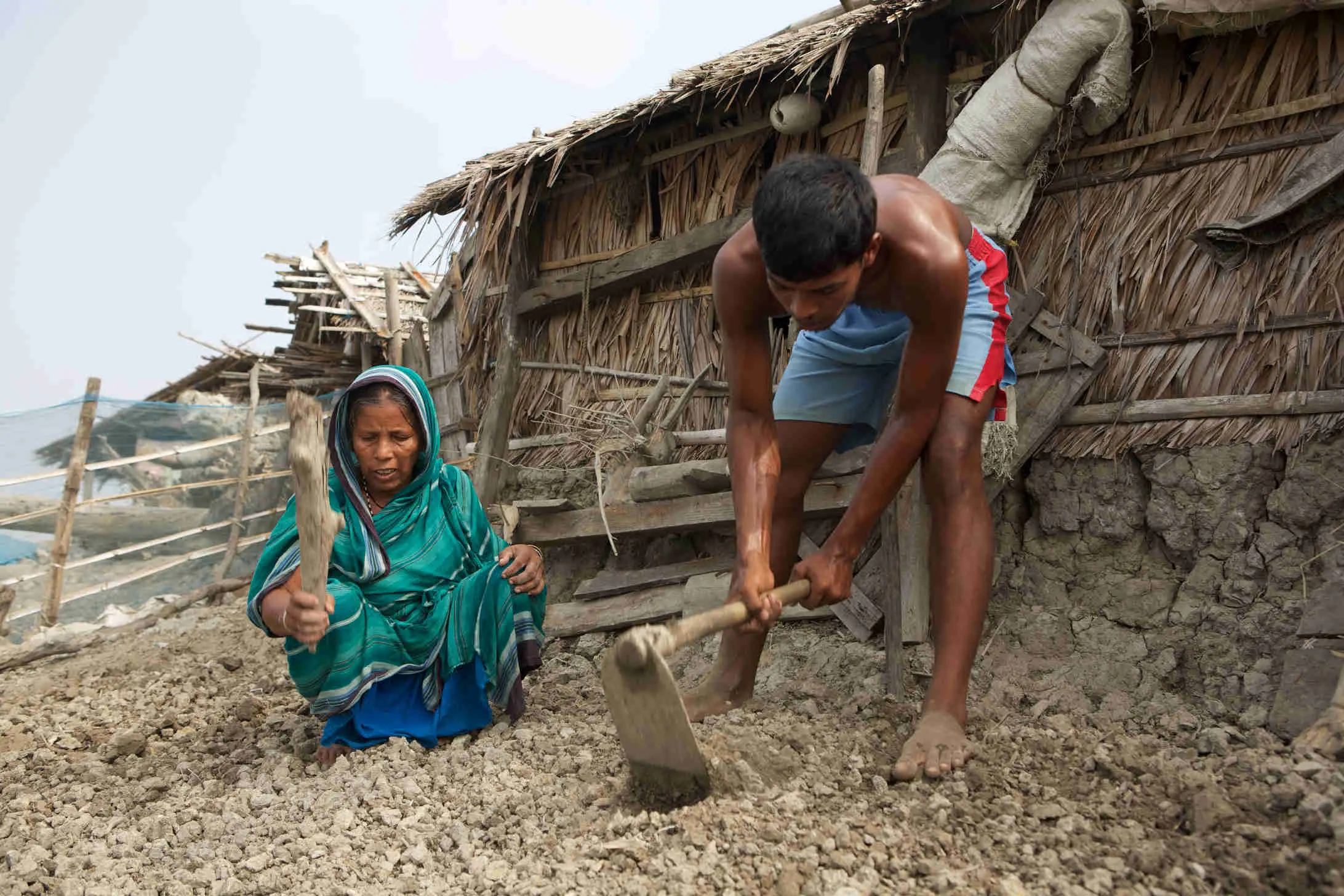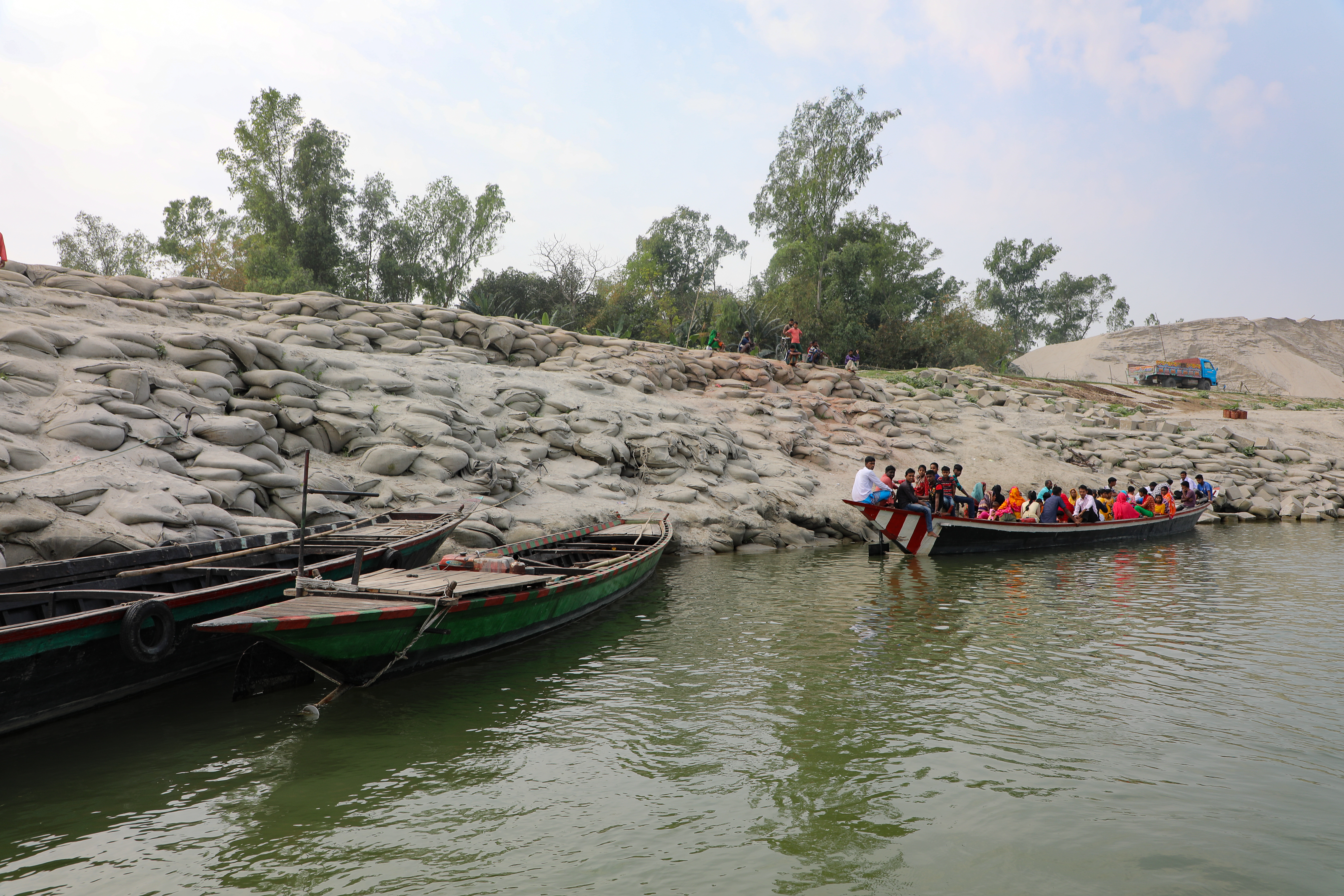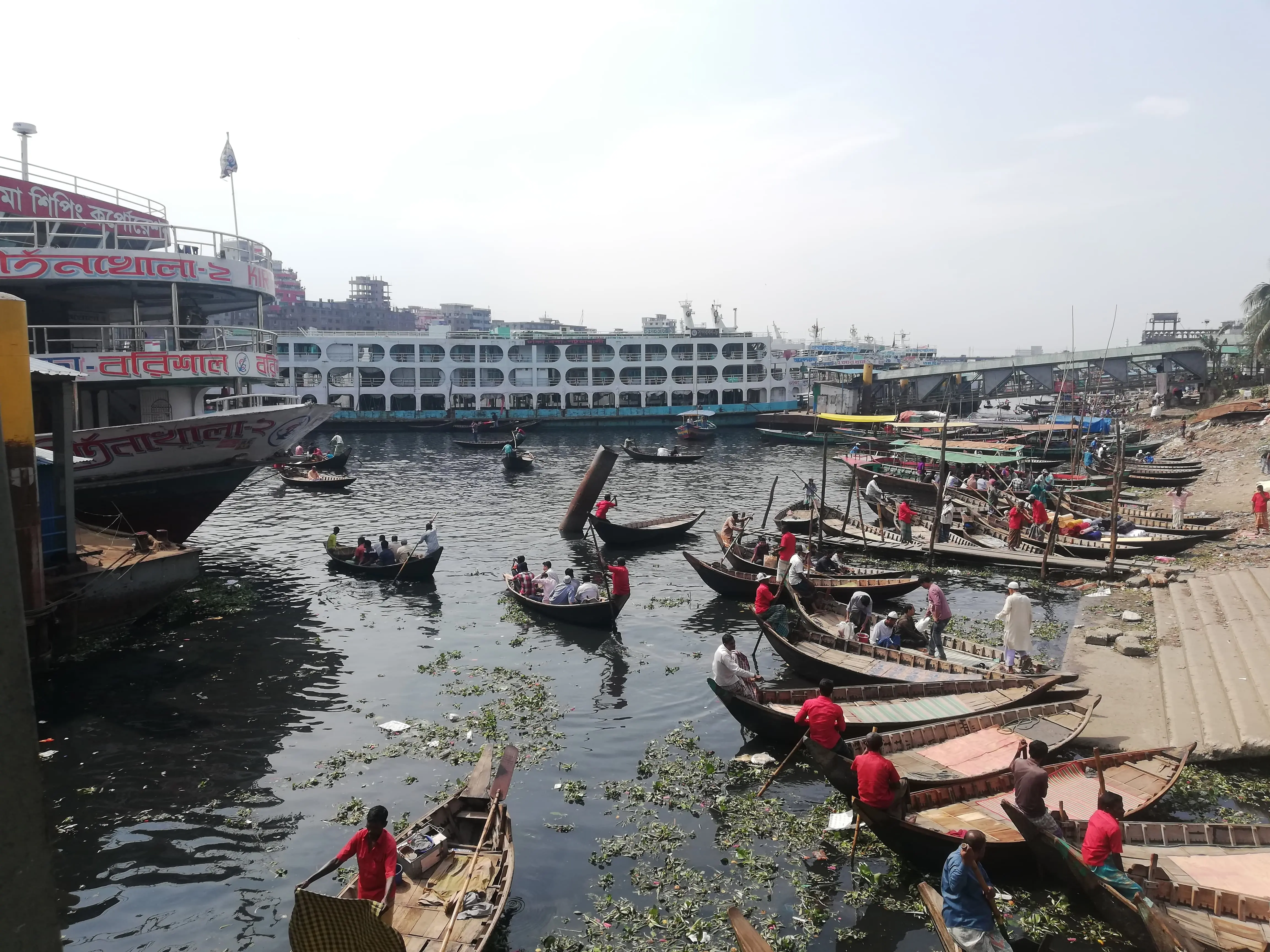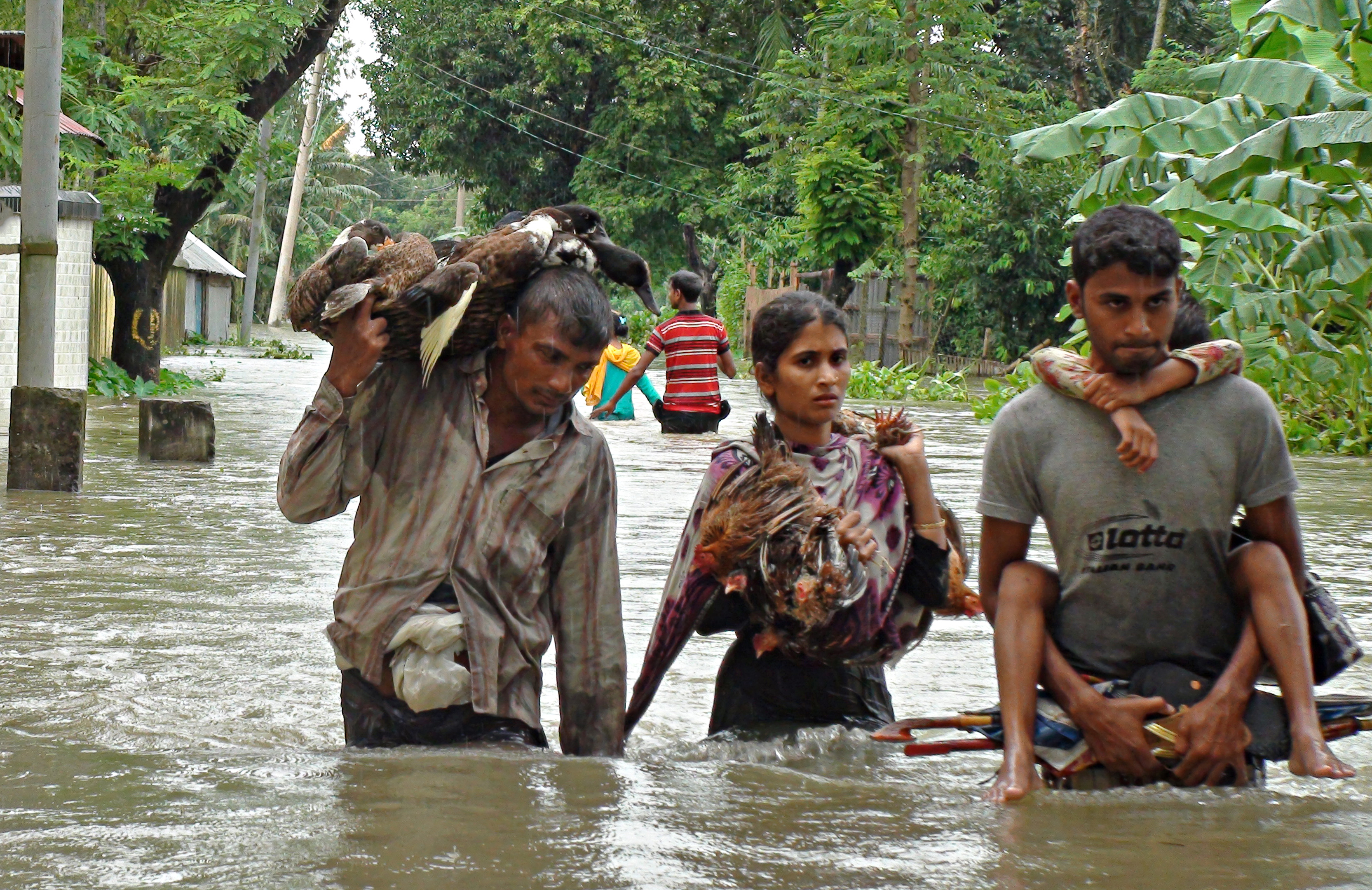Project Profile
Paribartan
Building the resilience of coastal communities in Bangladesh and India to prepare for and adapt to the effects of climate change.
Read MoreIn 2004, Concern warned of a growing humanitarian crisis in Bangladesh as flooding increased. Now, the country known as “ground zero for climate change” faces additional stress.
Purbita* is a fisherman’s widow who lives with her seven grown children in Kutubdia, Bangladesh. In the summer of 2017, the entire family was forced into a cyclone shelter when their house was one of the hardest hit by Cyclone Mora. When she returned from the shelter, Purbita found no signs of their home.
“I had to pass the days and nights under the open sky,” she explains. Not only was her family home destroyed, their livelihood was, too. Her eldest son worked in a local salt field, but lost his job due to Mora’s damage. “My family members and I had to suffer a lot due to [the] food and shelter crisis.”
But Purbita found a road to recovery. She was selected as one of 1,500 recipients of Concern’s unconditional cash transfers. Distributed in fragile contexts, often in the wake of a natural disaster, these multipurpose grants are given to those most affected by crises so that they can afford immediate necessities like temporary shelter, food, and healthcare. Purbita used her grant to purchase polythene, bamboo, and rope to construct a temporary shelter, along with soap, a water bPurbitaucket, rice, oil, salt, and vegetables. “Receiving such support was important at that time,” she adds. “Otherwise, it would have been very difficult to save my family members.”

The reality behind Purbita’s story (and thousands of others like hers) is that in Bangladesh, recovery is a constant cycle, because the effects of climate change are a constant reality.
Kutubdia was hit one year earlier by Cyclone Roanu. Drinking water facilities were contaminated in the flooding, and over 80% of the sanitation system was damaged by Cyclone Roanu.
“My house was over there. At low tide, we can still see signs of our house,” fellow resident Zainal Abedin told the New York Times in 2018. He was on a shoreline, pointing about 100 feet away into the Bay of Bengal. In that same article, the Times revealed the region of Kutubdia, which is an island that’s part of the larger Cox's Bazar district, has lost a full kilometer of shoreline since the 1960s. The saltwater poisons the rice paddies, and girls as young as 10 are married off by families who can no longer afford to provide for them.
This isn’t unique to Kutubdia, either. Two-thirds of the country sits less than five meters (roughly 16 feet) below sea level. An estimated 10% is only one meter (just over three feet) above sea level. Each year, 70% of the country is flooded during monsoon season. Approximately 80% of the land is classified as floodplain. These increasing and increasingly severe, seasonal crises lead to many families taking drastic measures towards survival.

An example of climate injustice: The United States produces 33 times the amount of carbon emissions as Bangladesh. Yet countries that are already most vulnerable to climate change feel the effects of those greenhouse gasses much more acutely. Bangladesh is consistently referred to as “ground zero for climate change” or a “disaster laboratory,” with the next flood always just around the corner.
One-third of the country’s calendar is designated as the monsoon season, which means that the country (just seven feet above sea level) is vulnerable to floods — especially as rains and other extreme weather patterns continue as a result of climate change.
The NRDC estimates that 50,000–200,000 Bangladeshis are displaced each year due to riverbank erosion alone, and a 2007 World Bank report estimates 300,000–400,000 citizens resettled as climate refugees in the capital city, Dhaka. They often end up living in the most vulnerable and poorest areas of the city, living as pavement dwellers and bathing in the contaminated water of the Buriganga River. The NRDC also quotes a climate expert prediction that, by 2050, the rising sea level will submerge an additional 17% of the country and uproot another 20 million people. This is in addition to the nearly 75% of the country already underwater, which in 2004 had already impacted 25.9 million people out of its then population of 141.3 million.
While Dhaka is seen as an option for many who are displaced by climate events, it is also faced with flooding. 40% of the city was submerged in 2004, which created havoc in a city of 14 million.
Such flooding has a ripple effect, affecting everything from public health, sanitation and sewage, food supplies, and the safety of marginalized populations (including women and children). 2004’s floods killed more than 285 people. Roads, train lines and embankments were washed away in 43 of the country’s 64 administrative districts, and that year’s floods were the most severe in 15 years.
With a long history in Bangladesh (almost as long as our own history as an organization), Concern responded to the 2004 floods. Then-country director Columba O’Dowd described a rapidly deteriorating situation in the flood zones. “People are struggling to survive in precarious shelters, without food or clean water.”
Over 15 years later, that deterioration continues.

At the time, O’Dowd warned of an impending humanitarian crisis, predicting major disruption to the lives of millions: “Crops are completely damaged and factories are closed, leaving vulnerable people with no source of income.” In the context of Bangladesh, where almost 50% of the population lives below the poverty line, this disruption in people’s lives meant that millions of families struggled to cope with both the immediate crisis and longer-term recovery.
In many cases, humanitarian predictions made in 2004 may be completely reversed in 2019. Sadly, 15 years later, Bangladesh has been struck by no fewer than 9 cyclones, beginning with Cyclone Akash in 2007. That year’s Cyclone Sidr was the deadliest, claiming the lives of over 3,500.
Yet while the number of deaths from large-scale disasters has dramatically decreased over the decades — due to robust preparedness and risk reduction efforts by the government in partnership with civilians — the economic damage and people affected by these disasters has remained fairly consistent. This creates further stress on an increasingly shrinking pool of resources, and increases the country’s overall risk of additional damage and vulnerability as these disasters increase.
In 2017, Cyclone Mora made landfall near Chittagong just after the tenth anniversary of Akash. This not only claimed Purbita’s home, but also destroyed at least 20,000 houses just in the refugee camps for Rohingya, who had been (and still are) exiled in Cox’s Bazar. This year’s floods in northern Bangladesh affected over 7 million people. Even during the monsoon season, this year’s rains were especially catastrophic, killing 119 and giving rise to nearly 15,000 medical cases (including everything from pneumonia to snake bites).

Extreme weather has been regarded as the “new normal” in Bangladesh, with estimates that sea levels will continue to rise this century by up to five feet (leaving the country just two feet above sea level). This will also increase the likelihood of these devastating storms and high tides — which have, until now, been expected once a decade but, by 2100, may be as regular as three to 15 times per year.
Where do these effects of climate change (and all they represent) leave the people of Bangladesh? Disaster response and readiness have become an integral part of ending extreme poverty in the country, not just for large-scale disasters but also for small-scale disasters whose damages add up to a cumulative impact. The most vulnerable people are those who are exposed to the risks of natural disaster and have no resources to build resilience against those risks — or recover post-disaster. Our first response is within these communities, with households such as Purbita’s, which need to meet immediate needs while figuring out next steps.
Concern has worked in Bangladesh for 50 years and has seen the cumulative effects of climate change firsthand. One of our recent flagship projects in the country, which ran from 2011 to 2016, was called Paribartan (meaning “transformation” in both Bangla and Odia), which helped develop community preparedness for climate change. Covering 204 communities across 6 districts in Bangladesh and neighboring India, Paribartan helped reduce the risk and vulnerability that can trap some of the world’s poorest communities in a cycle of poverty. The efforts continue today in the hands of local partner organizations.
Building this capacity for disaster risk reduction began with forming local committees, which in turn helped to voice the community’s concerns and needs — including the needs of community members often marginalized. Participants in this program began to build development plans with government officials. This gives officials a different way of approaching the communities they represent. It also gives communities a greater capacity to deal with the adverse impacts of climate change and extreme weather when they understand what can be done to mitigate disaster and adapt the local practices to better safeguard against future disasters. These community-led plans also mean that there’s a diversity of voices represented, and almost total buy-in from locals.
“For the first time we clearly see what risks we face and what resources we have in our village,” said Shantilata, a Paribartan participant from Odisha, India. “If you have the knowledge, then you can act on it!”
Early warning systems put into place by community leaders have saved lives in Bangladesh. When Cyclone Mahasen hit the country in 2013, the village team received the first warning via radio. Very few people had access to a radio, and locals were fatigued by a number of false warnings that had come in earlier.
During Mahasen, however, the local team mobilized its members and coordinated an evacuation plan. Though there was loss of property, no lives were lost. The cyclone itself wasn’t huge, but the warning dissemination process and the fact that people came together was very positive.
After recovery efforts from each storm, there’s still work to be done. Our focus in Bangladesh has been cultivation of crops in saline soils, using polythene plastic to help soil retain moisture and restrict leaching. Another solution is to adopt composite agriculture practices, which work by diversifying sources of income. Families can cultivate rice, fish, and vegetables in one area, and if one element fails, the others make up for it. This has helped to increase the income of some of Bangladesh’s most vulnerable farmers, and also meet nutritional demands for the families.
None of these solutions will be a silver bullet to solve all of Bangladesh’s climate issues. Nor will they reverse the impacts on the majority of the country already underwater. But they’re creating sustainable, lasting change that can help to keep this climate emergency from turning into a full-fledged humanitarian crisis.
*Some names have been changed for security
Correction: Due to a mistranslation, an earlier version of this article stated that 75% of Bangladesh sits below sea-level. We've amended that section of this piece and regret the error.